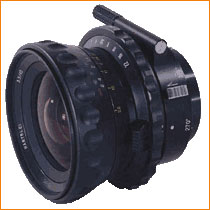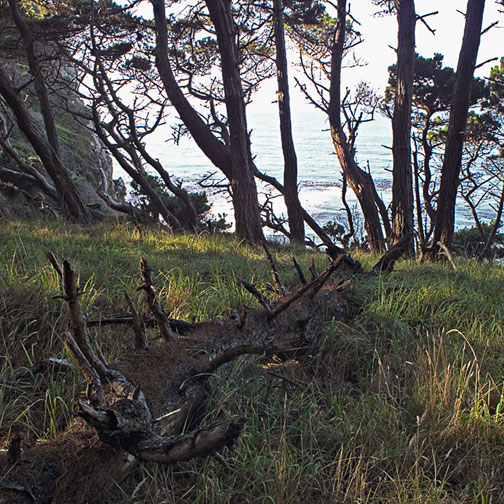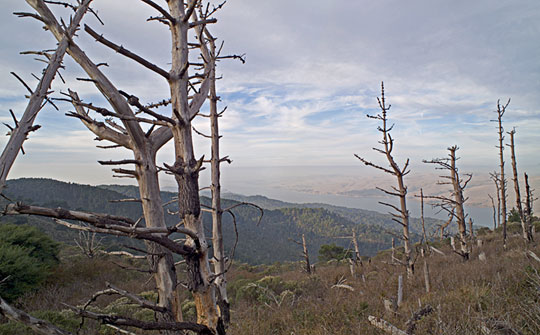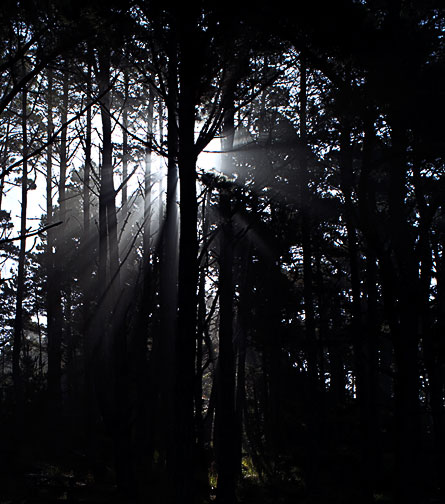
The problem withcommon wisdom, is that it’s often too common and rarely wise enough. One bit of so called common wisdom has been that Soviet made cameras and lenses were cheap and poorly made. Since I’ve had little exposure to such products, over the years I have simply taken such comments at face value. The odd Zenit occasionally seen on the second-hand shelves at camera shops did nothing to refute this perception.
But that was then and this is now, (to coin a phrase). I’m here to tell you about the latest addition to my medium format lens arsenal, theHartblei 45mm f/3.5 Super-Rotator, and in addition to singing its praises, to soundly affirm its many strengths.

Fig. 1
Log and Surf. Salt Point, CA. November, 2003
Contax 645 with Hartblei 45mm f/3.5 f.3.5 Super-Rotator lens
and Kodak DCS Pro Back at ISO 100
What is it Exactly, and Where Does it Come From?
Hartbleiis a Ukrainian lens manufacturer which sells its products around the world directly over the Internet rather than through traditional distributors and retailers. Apparently many of their designs were derived from Zeiss in post-war East Germany. What I’ve read is that Hartblei obtains its glass from Russia and does its own multi-coating, mechanical designs, optical mounting, and alignment.
Of the many lenses that this company makes my experience is limited to theHartblei 45mm f/3.5 Super-Rotator. While other lenses from this company may equal or even exceed this one (unlikely, since this is the top of their range), I have no experience or knowledge about them. So, please don’t write to ask me what I think of lens X or Y. I simply don’t know.
TheSuper-Rotatoris unique in the world of 645 medium format lenses. It is a medium wide angle (in 645 format terms) that offers full tilt and shift movements. It is available in fixed mount versions to fit Mamiya 645, Pentax 645 and Contax 645 cameras.
NB:This lens is also available in aPentacon 6mount with adaptors for 645 cameras as well as various 35mm cameras. I have no experience with these — only with the fixed mount version for the Contax 645, and by inference the two other fixed 645 mounts available.
While the lens is available in fixed mounts for these three autofocus cameras, it does not autofocus. It also does not have an autodiaphram or meter coupling. In other words, it mounts on the camera like any other lens, but you need to meter using an external hand-held light meter and then set the aperture and shutter speed manually. (Depending on the camera you may also be able to do manual "match-needle" meteringat shooting aperture). The diaphragm is also not pre-set, so it means that you have to focus with the lens wide open and then manually shut it down to the chosen shooting aperture before making an exposure. Sort of like working with a view camera, which is not an inappropriate comparison, since like with a view camera you have shifts for perspective control and swings (tilts) for the Scheimflug effect. (More on this further on).

Fig. 2
Barren Trees. Point Reyes, CA. November, 2003
Contax 645 with Hartblei 45mm f/3.5 f.3.5 Super-Rotator lens
and Kodak DCS Pro Back at ISO 100
Composited in Photoshop CS using Photomerge, from two frames — one shifted left and one shifted right.
What’s The Competition?
In a word or three – there isn’t any. In the 35 mm world Canon has three tilt/shift lenses; a 24mm, 45mm and a 90mm. These sell for a bit over $1,000 each and provide basic movements on two axis. The lenses come preset from the factory with the axes opposite each other, but a Canon service center can adjust them so that they are on the same axis. This way you can use Scheimfluganda rising front (for example) at the same time. I have found these lenses to be an invaluable part of my lens 35mm arsenal and indeed their availability was one of the reasons that I switched to Canon from Nikon in the mid-1990’s. (Nikon has an 85mm f/2.8 T/S lens, but I regard it as being of limited appeal for landscape and architectural work because of its focal length).
No other current 35mm lens maker offers tiltandshift lenses for 35mm cameras. One can use bellows attachments with short focus lenses for some macro work, but these have limited applicability for most photographers.
In the medium format world the situation is similar. Until recently Hasselblad had theArcbody, but unfortunately it was discontinued in 2001. It took proprietary Rodenstock lenses (three were available) and it accepted most standard Hasselblad viewfinders and film backs.
Hasselblad still sells theFlexBody,which offers limited movements withsomeHasselblad mount lenses. The problem here is that few lenses project a large enough image circle for this to provide a practical solution for field use.
Fuji offers theGX 680, the only medium format camera designed to offer basic lens movements, due to its built in bellows. It’s a great system, but more appropriate for studio rather that field use.
Finally, Rollei used to offer a tilt/shift lens for its6008series cameras. I always was intrigued, and wished I’d had one during the years that I owned a 6008 system, but the price was daunting, and the lens itself was the size of a baby’s head.
Otherwise, for the popular Mamiya 645, Pentax 645 and Contax 645 systems there isn’t a perspective control lens to be had, and this is where theHartblei 45mm f/3.5 Super-Rotatorcomes in.
I used to do a lot of large format photography, both commercially and for fine-art landscape work. I even used to teach workshops in view camera technique. But over time I found myself moving increasingly toward medium format for things that I used to use LF for. Lenses got better, film got better and I got older.
I then used aHasselblad Arcbodyfor a number of years and found it to be a very versatile system, but in the end I sold it because air travel was becoming too complicated to be able to travel with multiple camera systems.
When I switched to theContax 645system in early 2003 to use with theKodak 16 Megapixel DCS Pro Back, I was enamoured of the entire system and its Zeiss lenses, but I frequently find myself doing landscape work where I needed movements. The Arcbody was gone, and I couldn’t turn to the T/S lenses on the Canon because I usually travel with either one system or the other.
Browsing The Web
One day while browsing onebaylooking for a deal on some Contax accessories, I came across a listing for theHartblei Super-Rotator. At $995 this seemed too good to be true. A lens that would do just about everything that I wanted at a price similar to what Canon sells its T/S lenses for, and at less than half the price of a Contax Zeiss lens of the same focal length, even without movements.
I did some research but found that that there really wasn’t much in the way of informed and reliable commentary available about this specific lens. If I were to buy one I would be taking a risk, with little recourse. I might end up with the bottom of a pop bottle mounted inside of a tin can, or just maybe, a worthwhile lens that would do what I was looking for.
Being something of a risk taker I contacted the company via e-mail, asked a few questions, and putting my trust in the photography gods placed my order online. I was told that delivery would take about 2 weeks; I paid extra for FedEx delivery, and then sat back and waited. Ten days later FedEx knocked on my door with a package delivered directly from the factory in Kiev in the Ukraine.
No fancy packaging, just a rugged Styrofoam container inside of which was a lens case, with strap, and inside of that the lens, a front lens cap and an English language manual. No rear lens cap though. A certificate of inspection including a 1 year factory warranty on parts and labour was also included.

Fig. 3
Vertical Forest — Salt Point, CA. November, 2003
Contax 645 with Hartblei 45mm f/3.5 f.3.5 Super-Rotator lens
and Kodak DCS Pro Back at ISO 100
Out of The Box
Two things immediately impressed me. Taking off the front lens cap I saw that the lens elements were beautifully multicoated. They had that greenish tinge that one sees on some Zeiss and Pentax lenses, and which have to me always promised superior resistance to flare.
The second impression was — if this is how they build lenses in the Ukraine, then there are places in the Far East that should start to get nervous. No, the quality of craftsmanship was not quite up to Contax / Zeiss standards, and Schneider and Rollei aren’t going to loose too much sleep over it. But my tests and initial field use show that this lens is easily the equal of mainstream optics from any number of well-regarded European and Asian lens makers. Indeed the lens is completely made of metal. No plastics whatsoever, something that can’t be said for too many lenses these days.
Putting the lens on my Contax 645 I opened the diaphragm, looked though the viewfinder and turned the wide gripable focusing ring. Focusing was very smooth, with just the right amount of resistance, and no binding. All of the engraving (yes real engraving, not just paint), was clear, readable and comprehensive. The lens put me into a bit of a time warp, because in many ways it felt like a quality lens from the 1960’s — from when hand labour wasn’t the biggest cost component in manufacture, and when most consumer goods weren’t simply built to a price.
I sat down with the manual next and began to make sense of the multitude of knobs and levers that abound. At first it was confusing, but within 10 minutes I had it figured out.
The mechanical design is very clever. Cleverer in fact than that on the Canon T/S lenses, on which you can not change the orientation of the two axes without sending the lens back to a service center.
On theSuper-Rotatorthe lens actually has two completely separate axes of rotation, each of which can be moved through 360 degrees. What this means is that you can shift the lens to the right, or by releasing the front rotation ring rotate it 180 degrees and then shift it to the left. If you rotate the front rotation ring to 90 or 270 degrees you then have the view camera equivalent of a rising or a falling front. There are positive click stops every 15 degrees for all movements. 12 millimeters of shift is available in every direction.
Further in on the lens barrel there is a second rotation ring. With it in its top or “O” position there is a knurled knob that provides up to 8 degrees of tilt in any direction. Rotate the rear ring to 180 degrees and the tilt now moves upwards instead of downwards. Similarly you can set the angle of rotation on both the front and rear knobs to any angle within a 360 degree range, not just at the predetermined (and marked) click stops.
Because these two rotation rings and the tilt knob are completely independent of each other there is no limitation on combining tilts and shifts in any orientation. Nice!

In The Field
The lens arrived just a few days before a shoot I had scheduled along the California coast, and so I was able to dive right in to a real-world shooting situation. I made several hundred frames over a 5 day period on my Contax 645, with both my Kodak 16 MP digital back and also a 645 film back. Here is a quick evaluation of the critical aspects of this lens’ performance:
—Resolution:I was using theHartblei Super-Rotatoralongside my four Zeiss lenses. Though I haven’t done any resolution charts, when critically examining prints, and also on-screen images at 100% magnification, I can’t tell the Hartblei frames from the Zeiss frames when it comes to resolving power. Test charts may show otherwise, but not field work — at least so far.
—Flare:In Fig. 3 above I was shooting directly into the sun. I took the same shot at the same time with a Zeiss Distagon 35mm /3.5 lens and can see no difference in the amount of flare or contrast degradation.
—Vignetting:On the Kodak back with its reduced frame I can see no vignetting, even at extreme movements. On film, as long as one stays within the suggested shift range there is also no appreciable vignetting. As with all T/S lenses, it is important though to use the lens stopped down to minimize any possability of vignetting.
—Digital Chromatic Aberration:I had read that the Kodak medium format digital backs are susceptible to a form of chromatic aberration when used with tilt / shift lenses, because the fitted IR filter has diachronic elements that can scrozzle (a scientific term) the image. I twisted the Super-Rotator every which-way on dozens of different frames, and can not see any evidence of this. Another myth bites the dust.
—Ease of Use:This isn’t a terribly large lens and it has at least six different control rings, knobs and levers. Sometimes, depending on the lens’ positioning, it can get a bit tight to reach some controls. The levers that release the rotating segments are also appropriately stiff, to avoid accidental actuation, and so it takes some concentration to be sure that the right one is being turned in the right direction. No real complaints, though occasionally I found that I would accidentally move the focusing ring and would have to re-check focus.
Conclusion
Does it sound as if I’m enthusiastic about this lens? Yes, and with good reason. If the Super-Rotator cost $3,000 rather than $1,000, and if it had the Zeiss or Schneider name on it rather than Hartblei, no one would be surprised at such a positive review. But there will be those that say —no way! How can this (relatively) inexpensive lens from an unknown company in the Ukraine, of all places, be that good?
Well, I’m here to tell you that it is. If you use a Mamiya, Pentax or Contax 645 camera and if you do landscape, architectural or product photography, theHartblei 45mm f/3.5 Super-Rotatormay be one of the great bargain lenses to be found. No distributors, no retailers, no advertising — all of which add to a product’s final cost. Just the factory straight to you.
Highly recommended.
A live field report on the Super-Rotator will be featured
in an upcoming edition ofThe Luminous Landscape Video Journal.
Not yet a subscriber?
Unbelievable!
You May Also Enjoy...
December 2000
Critique Submissions‚ December, 2000 This page contains submissions made during December, 2000 from photographers who wished to have their photographs reviewed by the publisher of
Outside The Church
Please use your browser's BACK button to return to the page that brought you here.
